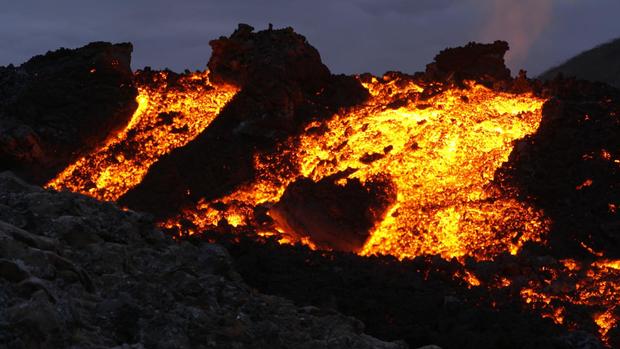Warmer temperatures are melting the glaciers that sit like pressurized lids on many of the world’s most volatile volcanoes.
In Iceland, one of the few countries that actively monitors its volcanoes, glaciers push down on the earth, geophysicist Freysteinn Sigmundsson told Bill Whitaker. The retreat of glaciers in Iceland is causing more magma to stir deep beneath the earth’s crust.
“Retreating glaciers can increase the possibility of eruptions,” Sigmundsson said.
Iceland, known as the Land of Fire and Ice, dealt with two eruptions in recent years. In 2021, Geldingadalir erupted. Chunks of molten rock the size of cars cartwheeled into the air. Lava boiled up through nine vents and poured into the valley for months.
In early August 2022, a new fissure opened and the same volcano exploded again.
Both eruptions were highly unusual, Kristin Jonsdottir, head of Earth Sciences at Iceland’s meteorological office, said. Months before the eruption, magma stirred beneath the earth and triggered tens of thousands of earthquakes. Usually, these quake storms reach a crescendo before the eruption. Instead, they went silent — only when the tremors stopped did the volcano erupt.
“So this was something we didn’t expect because before most eruptions, we see an escalation in the process,” Jonsdottir said. “So we see more and bigger earthquakes the closer we come to an eruption.”
Ahead of the second eruption in August 2022, scientists weren’t fooled when the earthquakes stopped. They ran tests that showed the volcano wasn’t sleeping. Rocks were still moving and gas was still escaping. Scientists called an audible – and warned the volcano would likely blow within 24 hours. They were right.
Sigmundsson wants to find out if this seismic decline before an eruption might apply to similar volcanoes in Japan, Russia or the United States.
Right now, Iceland is one of the few places in the world to actively monitor its volcanoes, which it does via an extensive system of highly specialized instruments. The lack of monitoring elsewhere can sometimes spell disaster, like the 2018 bang out of the blue in Indonesia that killed 400 people. Cornell geophysicist Matthew Pritchard told Whitaker volcanologists have got to do a better job. Only around 35% of volcanoes that have erupted in the last 500 years are continuously monitored.
Maintaining the instruments to monitor the potentially dangerous volcanoes can be expensive.
“So, it’s all a question of priorities. It’s a question of resources,” Pritchard said.
In Iceland, Ed Marshall, a Texas-trained geophysicist at the University of Iceland, uses an instrument called Inductively Coupled Plasma Optical Emissions Spectrometer to measure the chemical composition of the lava and determine what part of the earth it came from.
Some red-hot lava oozed out of the volcano while other lava exploded, moving as fast as 10 miles an hour.
“The rate at which these different flows can advance and move is different,” Marshall said. “So it’s important to figure it out because they have different hazard potential.”
Some volcanoes, including Iceland’s Grímsvötn, are more difficult to monitor. Grímsvötn is hidden beneath a glacier, so seismologist Kristin Jonsdottir and her European partners tried something new – burying a coil of fiber optic cables in the ice cap. The cable is even thinner than a human hair.
Where regular seismometers barely registered a pulse, the fiber optic cable showed Grímsvötn was grumbling irritably inside its icy tomb. It picked up 100 times more quakes. Jonsdottir said it could be a game-changer.
“So the potential here is really to be able to understand the volcanoes and the plumbing system,” Jonsdottir said. “You know, just being able to see this high-definition picture that we were not able to see before.”
There is another solution on hand to better monitor volcanoes, Pritchard said. He’s spearheading an effort to establish a satellite network that will continuously monitor the world’s most restless volcanoes. Pritchard said the new gold standard would be to combine ground sensors with satellite images to help detect eruptions earlier.
Next year, a new satellite will be launched that will use radar waves capable of penetrating dense jungle or snow, and seeing deeper underground than ever before, potentially turbocharging the ability of volcanologists to forecast eruptions.
In Iceland, Jonsdottir said she expects more eruptions from the Fagradalsfjall volcano, adding that this time, they know better what to look for.
“Right now, we are not seeing anything, but we also know that this can happen quite quickly,” Jonsdottir said. “I think we need to be prepared for that, that the warning time we have is not necessarily gonna be many weeks, but maybe just a couple of days.”



